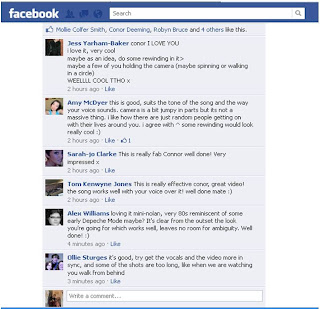For our media coursework we chose to do a music video and the two ancillary products, a DigiPak and an advert for a DigiPak. I chose this because I have an interest in music, I was interested to find out the ways in which music videos are created and the aspect of music as a media and how it can be seen as a form of media.
We chose the genre of pop for the music being as it is a genre of music we both like and we felt that if we chose any other genre we would have to do much more in depth research. When shooting the music video and DigiPak photographs, had the idea of using the same place to shoot the video and photographs so the target audience could also relate to where the artist was from.
When making the products I was influenced by the film makers Anton Corbijn and Walter Stern. Corbijn uses imagery as a focal point in his music videos as seen in his work with Nirvana (Heart Shaped Box) and Joy Division (Atmosphere). Through Stern's work I took the simplicty of the video and how watching his work it can be very simple but then effective for the audience viewing it. This is seen his work with Massive Attack (Teardrop) and Nine Inch Nails (Into the Void).
There have been many new technologies I have used when working on my moving image product and the two ancillary tasks.
Blogger
When we first created our coursework blog, we chose the site Blogger for us to post our information on being as we found it easy to use and we both could access the site through our smart phones. This was very effective because even if we weren't at a computer screen we could still post information up wherever we were.
YouTube
Through using YouTube we were able to show our final product to a mass audience and also get critical feedback on our final product.
Facebook was used as part of the audience feedback process. We also found if we posted the video later in the evening then more people would be able to view it because more people would be online at that point. This was the case and from this we were given essential feedback.
I set up a Twitter account for the artist featured in our coursework and posted the link to the video on YouTube on the account so we could receive audience feedback from a different professional perspective.
When creating the ancillary tasks we used PhotoShop CS3 to make and edit the DigiPak and the DigiPak advert. It is through this software we were able to make the DigiPak and advert look as professional as possible with use of different fonts, colours and editing techniques such as changing colour level on the photos and taking out red-eye from the model in the DigiPak advert.
Final Cut Pro was the software used for when we created and edited the moving image product. Because we had never used the software before we were apprehensive after filming the footage. As soon as it was explained to us we found the process easy being as the concept of our video was simple. Through this software we could cut out film clips we didn't want or need in the final film, place the track on easily and put the shots together in a way that made a product that has been well received.

















